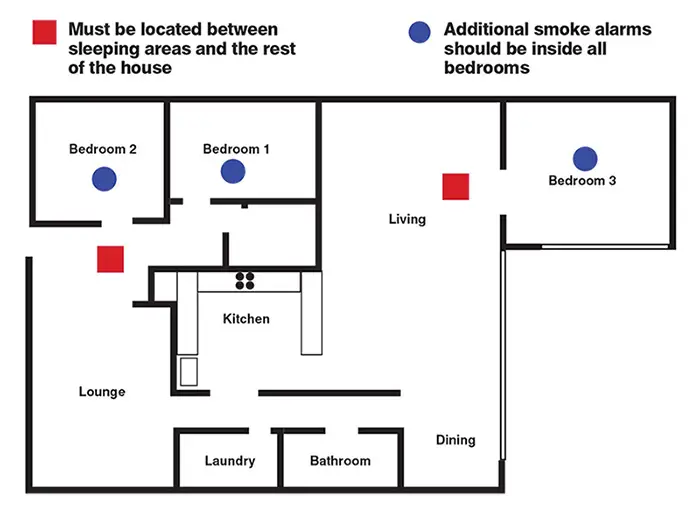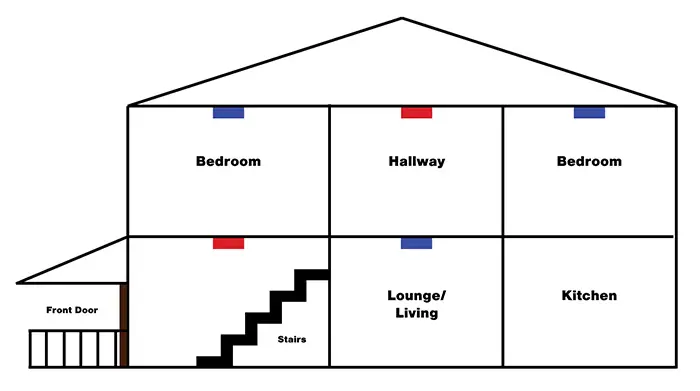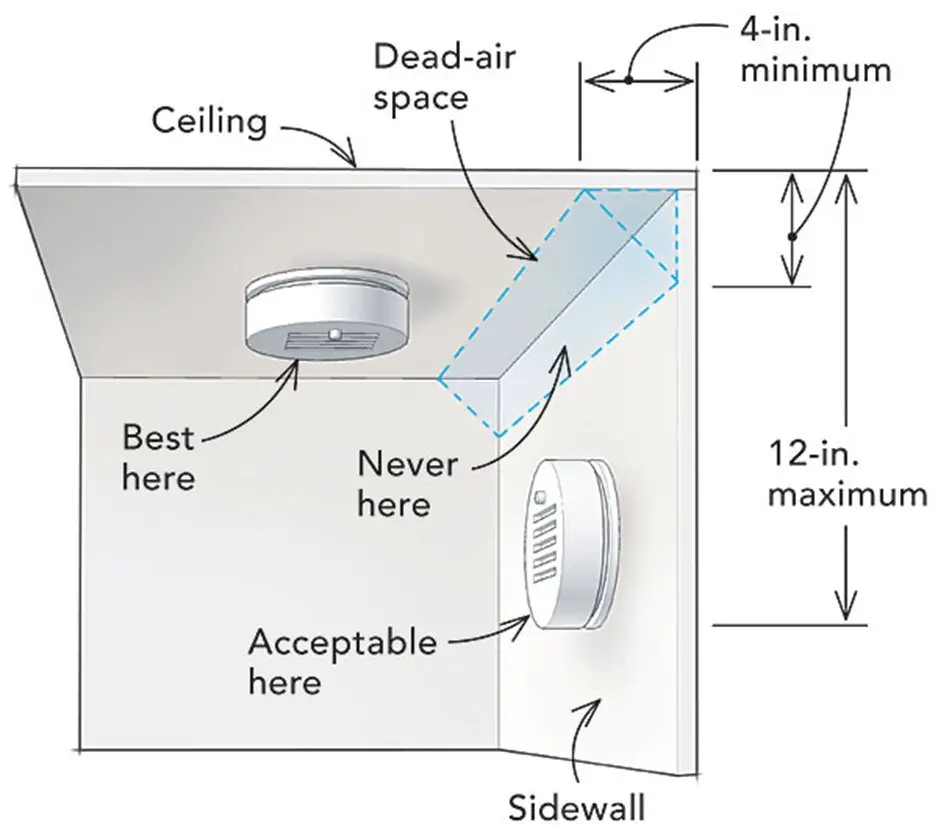Proper smoke detector placement is essential for early fire detection, granting precious escape time during an emergency.
This guide covers the best smoke alarm locations and positioning, and which to avoid, ensuring your home’s safety isn’t left to chance. It also includes example placement diagrams to serve as visual aids for helping you achieve optimization fire alarm installation.
Key Locations for Smoke Detector Placement
Recommended placement of smoke detector alarms is inside each bedroom, outside each sleeping area, and on every level of the home, including the basement. On levels without bedrooms, install alarms in the living room or near the stairway to the upper level, or in both locations.
Note: These recommendations come directly from the National Fire Protection Agency (NFPA), an international non-profit organization that develops and publishes fire protection codes and standards.
Inside Bedrooms and Outside Sleeping Areas
Reasoning: Fires can occur anywhere in the home, but bedrooms are crucial locations because fires often happen at night while people are asleep. Smoke inhalation is a major danger in fires, and occupants may not be awakened by the smell of smoke alone. Having an alarm inside the bedroom provides the earliest possible warning, giving occupants valuable time to escape. An additional alarm outside the sleeping area ensures the alarm is heard even if the bedroom door is closed.
Every Level of the Home, Including the Basement
Reasoning: Smoke rises, so having alarms on every level is essential. A fire in the basement could quickly spread to upper floors, and an alarm on that level would be the first to detect it. Similarly, a fire upstairs could trap occupants downstairs if there’s no alarm on that level. Whole-home coverage ensures regardless of where a fire starts, an alarm will sound throughout the house.
Living Room or Near Stairway on Levels Without Bedrooms
Reasoning: On levels without bedrooms, common areas like living rooms are often occupied in the evening and can be potential fire starting points. Placing an alarm near the stairway to the upper level ensures it will be heard throughout the floor and alert occupants on upper floors as well. Ideally, installing alarms in both locations (living room and stairway) provides maximum coverage.
Smoke Detector Placement Diagrams
Here are a few diagrams showing the proper placement of smoke detectors in the home:



Smoke Alarm Locations to Avoid
Here are some locations to avoid when installing a smoke alarm:
- Kitchens and Bathrooms: Avoid placing alarms directly in kitchens and bathrooms due to cooking fumes and steam that can trigger false alarms.
- Near Vents and Fans: Air currents from vents and fans can blow smoke away from the fire alarm, hindering its ability to detect smoke effectively.
- Corners of Ceilings: Smoke tends to pool in the center of a ceiling before dispersing. Placing smoke detectors in corners reduces their ability to detect smoke promptly.
- Dead Zones: Avoid placing alarms directly above furniture or doors, as these can create dead zones where smoke may not reach the alarm.
- Drafty Areas: Avoid hallways with strong drafts from doors or windows, as drafts can similarly hinder smoke detection.
- Unheated/Uncooled Spaces: Extreme temperatures (too hot or too cold) can damage smoke alarms or interfere with their operation. Avoid garages, unfinished attics, or unheated basements.
- Dusty or Dirty Areas: Dust and dirt buildup can clog fire alarm sensors and reduce their effectiveness. For this reason, avoid garages, workshops, or laundry rooms.
Proper Mounting Techniques for Smoke Detector Alarms
Ceiling vs. Wall Mounting
Ceiling Placement (Preferred): Smoke rises, so ceiling mounting offers the most effective coverage. Alarms placed on the ceiling are less susceptible to dust buildup and drafts that can interfere with detection.
Wall Mounting (Acceptable): If ceiling mounting isn’t feasible, wall mounting is an option. However, ensure the alarm is installed:
- No lower than 4 inches from the ceiling to avoid dead air zones where smoke might not reach the sensor.
- Ideally, mounted between 4 and 12 inches from the ceiling for optimal smoke detection.
Distance from Walls and Corners
Avoid Corners: Smoke tends to pool in the center of a ceiling before dispersing outwards. Placing alarms in corners traps smoke and delays detection. Maintain a minimum distance of 4 inches from both walls and corners when mounting on a ceiling.
Distance from Walls (Wall-Mounted Alarms): Even with wall mounting, maintain a minimum distance of 4 inches from walls to ensure smoke can reach the sensor effectively.
Placement on Sloped Ceilings
For vaulted or angled ceilings with a slope greater than 4/12 (vertical rise of 4 inches for every 12 inches of horizontal distance), it’s best to install the alarm within 3 feet of the peak, measured horizontally along the slope.
Important: Avoid placing the alarm directly at the peak of the slope, maintain at least 4 inches of distance from the highest point to prevent dead air pockets.
Additional Considerations for Smoke Alarm Placement
Alarm Maintenance:
- Never paint smoke alarms. Paint, stickers, or other decorations can clog the sensor and prevent the alarm from functioning properly.
- Clean smoke alarms regularly. Use a vacuum cleaner with a soft brush attachment to remove dust and cobwebs from the vents every month.
Interconnected Alarms:
- For best protection, interconnect all smoke alarms. When one alarm detects smoke, all interconnected alarms throughout the house will sound. This provides earlier warning and a better chance of escape, especially for occupants in distant areas of the house.
- Interconnection methods: Alarms can be interconnected using hard-wiring during installation or wireless technology with battery-operated interconnected units.
- Compatibility for interconnected systems: Ensure all interconnected alarms are from the same manufacturer or are specifically listed as compatible for interconnection. Incompatible alarms may not communicate and sound together, defeating the purpose of interconnection.
Types of Smoke Alarms:
- Ionization vs Photoelectric Smoke Detectors: There are two main types of smoke alarms:
- Ionization alarms: More responsive to flaming fires that produce larger smoke particles. One of the Best: First Alert Ionization Smoke Alarm
- Photoelectric alarms: More responsive to smoldering fires that produce smaller smoke particles. One of the Best: Kidde Photelectric Battery Smoke Alarm
- Dual Sensor Alarms (Recommended): For the most comprehensive protection, consider installing combination ionization-photoelectric alarms (also known as dual sensor alarms). These combine the strengths of both types, detecting a wider range of fire types. One of the Best: First Alert Dual-Sensor Battery Smoke Alarm
Documentation:
- Keep the manufacturer’s instructions for reference. These instructions will provide specific details on your particular alarm model, including maintenance procedures, troubleshooting tips, and end-of-life replacement recommendations.
Wrapping Up
Proper smoke detector placement is crucial for your home’s fire safety. By following these guidelines for smoke alarm positioning in the best places to put fire alarms throughout your house, you can ensure the earliest possible warning in case of a fire.
Remember to check your existing smoke alarm placement and make adjustments if needed. Don’t wait – take action today to safeguard your home and your loved ones!
